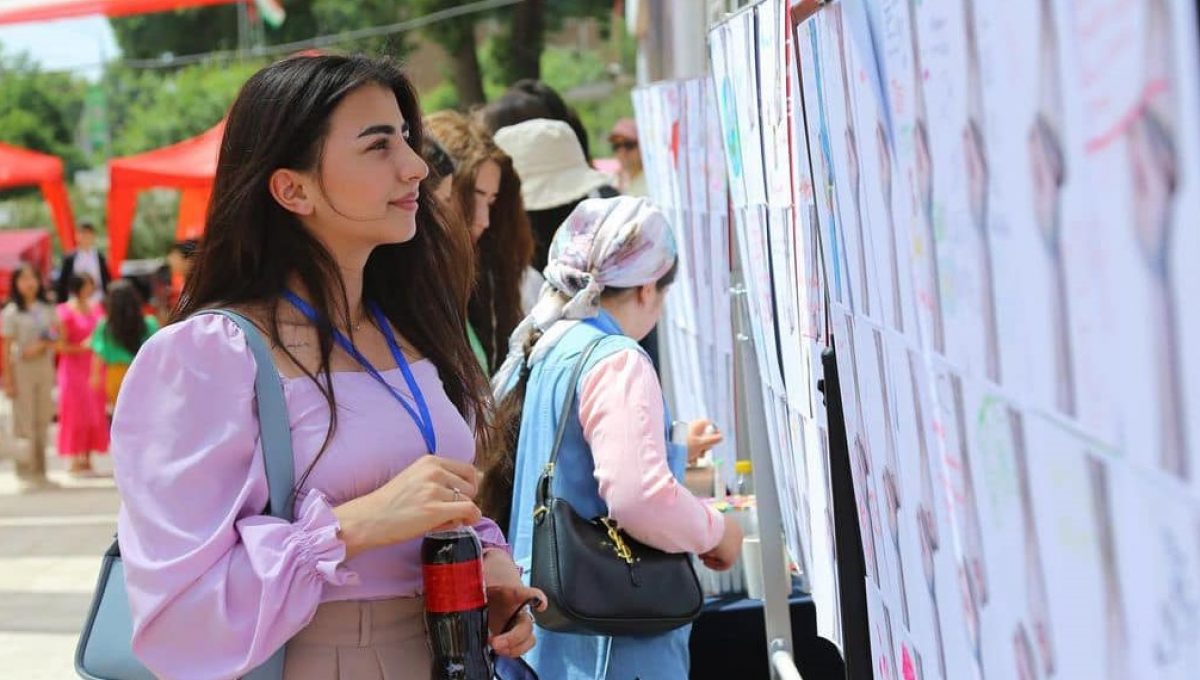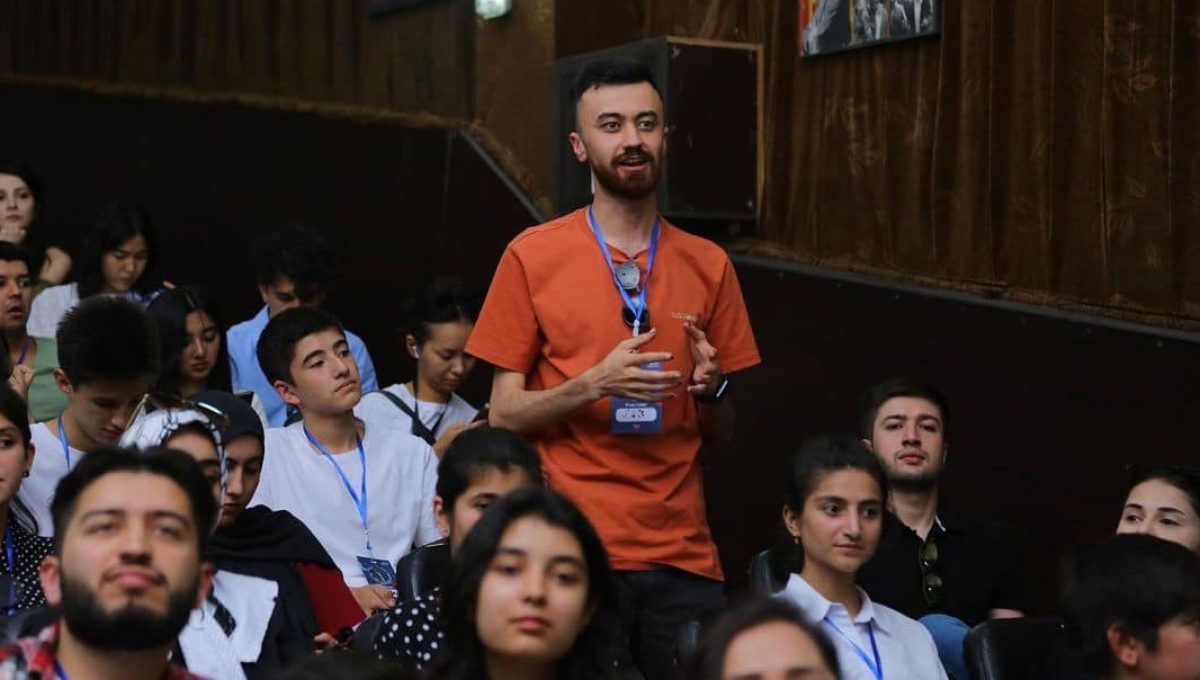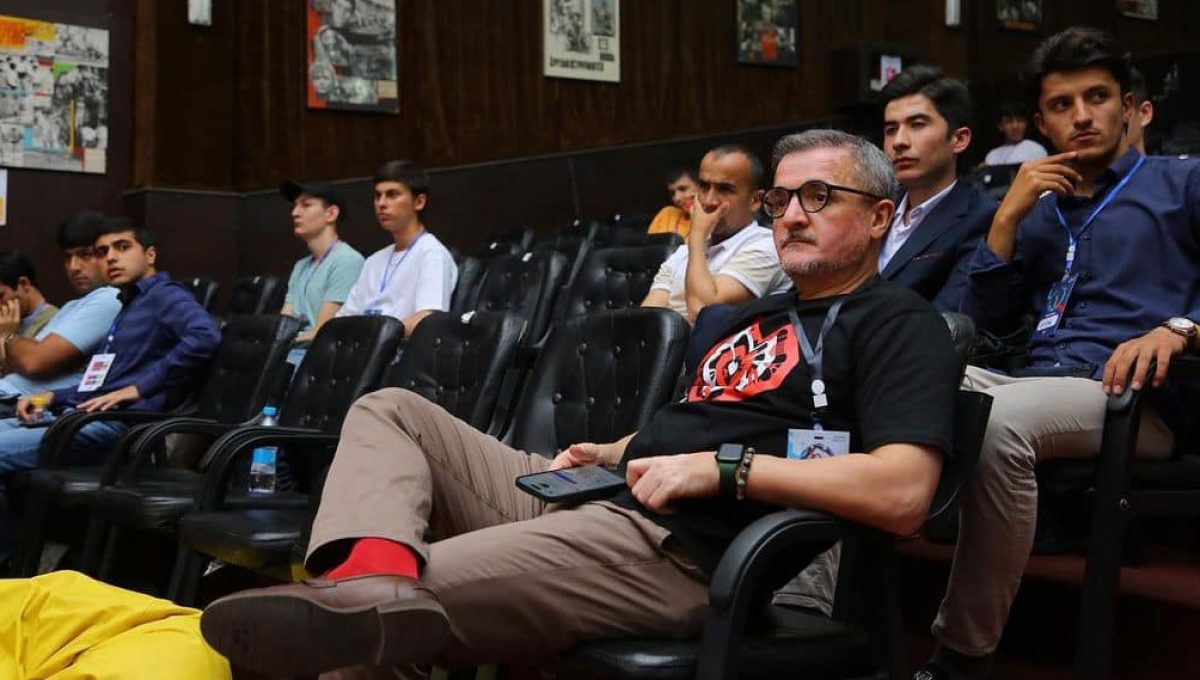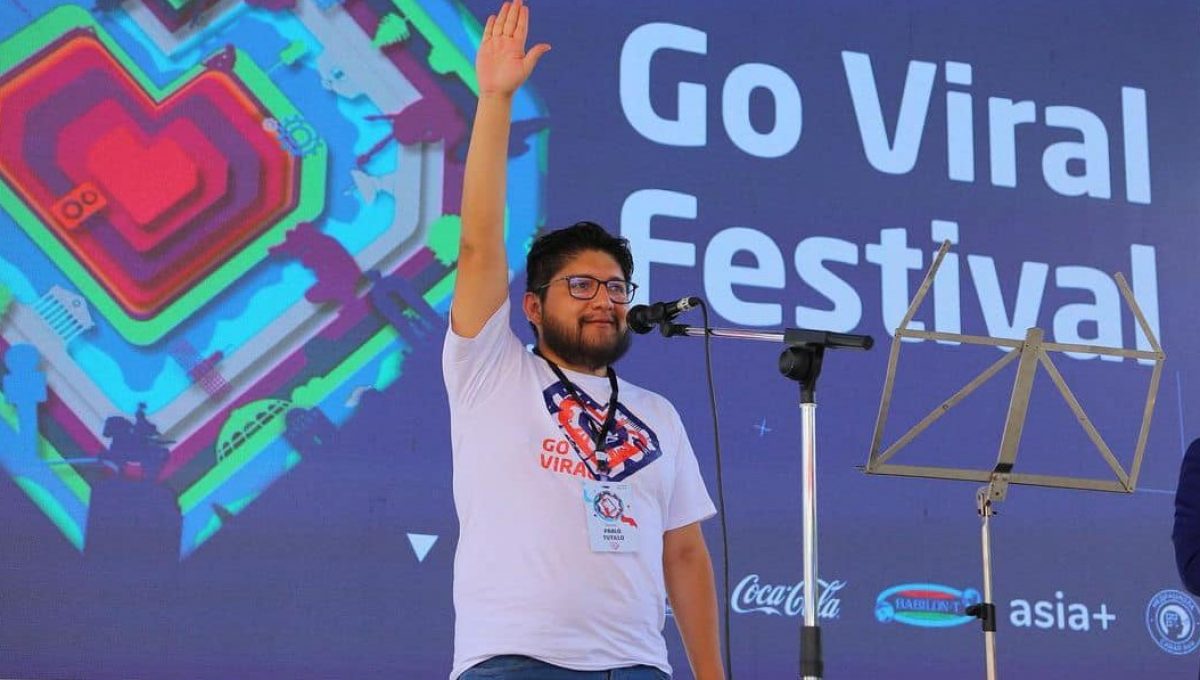The second day of the seventh Go Viral Festival in Dushanbe held on 27 May, organized by IWPR Central Asia, was no less exciting than the first day. More than 500 participants came to the Zebunniso Cinema that day to gain new knowledge, expand their network and learn about innovative ideas of modern Tajikistan in the media, business, culture and IT.
 Speaking at the opening of the second day, Pablo Tutillo Maldonado, Public Diplomacy Officer at the US Embassy in Dushanbe, described his dream of learning different foreign languages, which he has made a reality despite difficulties and barriers.
Speaking at the opening of the second day, Pablo Tutillo Maldonado, Public Diplomacy Officer at the US Embassy in Dushanbe, described his dream of learning different foreign languages, which he has made a reality despite difficulties and barriers.
“Don’t let anyone stop the process of dreaming, keep on dreaming and creating,” Pablo said.
Anand Krishna, Head of Press, Culture and Education at the US Consulate General in Almaty, also gave a motivating speech to the festival participants.
“Every one of us has a dream. If you are passionate about something, do it, collaborate and create,” Anand said.
Think about the message!
The first session of the second day in the cultural sector was opened by Munira Akilova, founder of the Munir brand, trainer and expert in craftsmanship, tourism and entrepreneurship. The session focused on the theme of art and design.
The brand’s mission is research, training and production in craftsmanship.
“In 2003, I left teaching and with the help of one needle that I had, I moved into the field of craftsmanship,” Munira said.
She said they are trying to transform traditional ornaments into more contemporary products.
“We aim to transform and transmit ornaments in a new format,” notes Munira.
She also spoke about the history and value of traditional Tajik ornaments and their deep connection to different elements of nature and life.
“When you make your design, think about the message you want to convey, what story it will tell,” Munira added.
She talked about ways to convey the importance of the intent and message in your product using 10 symbols that are often utilised in handicrafts.
Art as a tool for social change was the title of the session in the culture sector, where Veronique Dukler provided the young participants with her tips on how to use art and creativity to express oneself and trigger social change processes.
Veronique talked about the history of artivism and Dadaism, social and political phenomena that combined art, activism and self-expression. She gave examples of works by Francisco Goya, Gustave Courbet and Marthe Rosler, which were critical of the exploitation of workers in France and the wars in Spain and Vietnam.
Veronique highlighted the work of the Tajikistani initiative group Tell me sister, which has become a platform for many women who have faced domestic violence, harassment and violations of rights and freedoms.
“Some brave women gave a voice and an opportunity to be heard to other brave women who did not have a voice and an opportunity to speak out,” said Veronique.
When asked by a session participant what elements in artivism and street art are fundamentally important, Veronique said that “clarity, readability and comprehensibility of the message are very important”.
“People from different social and cultural backgrounds need to understand your message,” said Veronique.
Who should be concerned about artificial intelligence?
At the panel discussion “Applying Artificial Intelligence (AI) in Different Industries: Practical Aspects and Challenges”, expert Siyovush Muminov spoke about how AI is being used at Alif Bank in Tajikistan. In particular, AI reads customers’ passport data and enters them into the system. Every other loan application is approved by the AI, and there are also plans to launch a voice assistant, a recommendation system, automation of loan review, etc.
Amira Ibragimova, the co-founder of the RobX school of robotics and programming, explained how AI is widely used in creating robots. The robots created must sense time, think in real-time, analyse, react and perform tasks in real-time as well.
Akhliddin Nizomitdinov explained to participants the essence of machine learning and AI.
Machine learning algorithms are based on mathematical statistics. AI consists of machine learning, deep learning based on neural networks and Big Data. At Zyplan in 2021, he said, they have started developing a credit scoring system for assessing creditworthiness.
“We are constantly improving this product by using machine learning and AI to increase the percentage of predictive accuracy,” Nizomitdinov said.
According to Manuchehr Ghafforzoda, machine learning is a solution to a problem without having to write code.
“You show a lot of items and the AI starts to understand what you want,” he added.
Manuchehr Ghafforzoda noted the importance of Big Data (lots of data) for the development of AI.
“The more data, the better the AI will learn and the more accurate information will be generated,” Ghafforzoda said.
At the session, the negative consequences of AI evolution were also discussed.
Amira Ibragimova also noted the risks involved – robots are not always trained correctly and can cause harm, as there is no control and regulation in this area yet.
“The main challenges are reliability and security, ethical regulations and a small volume of data. All this makes it impossible for us to predict how a robot will behave,” Ibragimova said.
Two important issues were highlighted by Manuchehr Ghafforzoda: how to keep AI under control and how to teach it to share human values. The first will allow us to regulate and control the AI, and the second – to set the right parameters for it.
Responding to a question on how real data can be handled in Tajikistan, Akhliddin Nizomitdinov, said that in the last 5 years, the country has started developing data collection, but so far it is not sufficient.
“If it’s about the economy, we still have data and can make some forecasts, but not in other areas. Therefore, we are looking to foreign sources, such as the Kaggle platform,” the expert specified.
Siyovush Muminov believes that while AI cannot replace humans yet, it can influence hiring policies.
“Somewhere we will replace humans to optimise costs and time. The first thing to worry about is people who do routine work. But remember that a good professional will never be out of a job,” believes Muminov.
Building a personal brand step by step
Another session in the media section focused on sustainable scaling for the digital world, led by Meagan Ward, founder and CEO of branding agency Femology.
She began the session by mentioning the international crisis of 2008 when she was a university student. Her mother as well as many people she knew had lost their jobs and this was the turning point when she decided to go into the field of graphic design.
“I started learning Adobe software and programming languages on my own. I started sharing even my smallest achievements on social media, and step by step built my personal brand,” Meagan stated.
She paid particular attention to company branding and personal branding.
“Personal branding can help you increase awareness of your product, build community, become financially free and discover new opportunities for yourself,” Megan added.
Don’t be afraid of a shaky camera!
Stas Chebotar, video maker, blogger and realsmaker talked about how to make a social video go viral. According to him, there are four stages in creating a video clip.
The first stage is the idea.
“You can’t have anything without an idea. You have to generate content 24/7. Constantly,” says Stanislav.
He advises recording all ideas on a tape recorder, and if there are no ideas, you need to clear your mind.
“When I can’t think of an idea, I sit against a white wall. I stare into the white, empty wall. I turn off all thoughts. A thought comes, and I blow it away. The brain gets bored. The brain is best at perceiving kitties. But when there is no information, the brain starts generating ideas,” he says.
The second stage is to write the script. You need to reveal the title in the video and give the audience useful information.
“You don’t need the coolest camera to make a video, you need straight hands and a head,” he notes.
The third step is filming.
“Don’t be afraid of a shaky camera. If you have a really cool idea, it will be catchy,” Chebotar says.
The fourth stage is editing. The speaker gave useful tips to the audience and suggested CapCut software for editing.
“Don’t shoot dance or kitties, it’s hard to monetise. It’s better to show your expertise in your field,” advised Chebotar.
The session ended with a game. Session participants were divided into teams and filmed their short videos. The winners received a free one-hour consultation with Stanislav Cebotar.
Digital canvas: exploring augmented reality in art
The speaker, a special guest from Kazakhstan, 3D CG designer and artist Zhanar Abrayeva spoke about augmented and virtual reality.
The purpose of this session was to show virtual reality from an artist’s point of view.
During the quarantine, Zhanar started creating virtual clothing.
“During the quarantine there was an increased demand for virtual clothes, at this time I started exploring this field,” she says.
Zhanar says that all professionals, regardless of what they do, should not be afraid to express themselves online.
“It is obligatory for specialists of all professions to publish – show their work, the process, because, based on my experience, you will find your person, your audience, then your manager, and after that – the place of work,” advises Abraeva.
She also talked about AR masks, which are already widely used in social media such as Instagram.
“People use such masks to create a wow effect in the content for their page,” says Zhanar
Designers use virtual clothing extensively in their work.
“It’s a cool programme to first visualise a design and check the audience’s reaction, whether they like the design or not. If it’s successful, you can send everything to production,” Abraeva said.
At the end of the session, Zhanar held a master class where everyone in the session could learn how to create AR masks for Instagram.
Don’t be afraid to show your face
The final session in the culture sector focused on the theme of spreading socially relevant ideas on Instagram, led by speaker Farzona Saidzoda, a representative of the Tell me sister initiative group.
Farzona stressed the importance of storytelling through the human face, its story, emotions, experiences and joy.
“It is very important that your page is not faceless, don’t be afraid to show your face and speak to your audience,” Farzona said.
Talking about the effective dissemination of socially relevant ideas, Farzona advised the session participants to try to keep it simple and concise when creating content and have a team of like-minded people when promoting a particular socially relevant issue.
“If you want to start a social project and promote it, it will be easier and more effective if you have a team,” Farzona added.
The festival concluded with a concert. The next regional Go Viral festivals will be held in Astana and Ashgabat.









